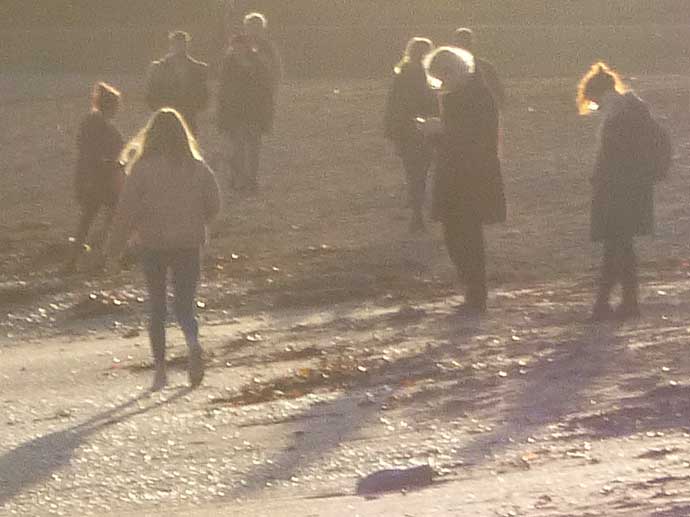I started with movement, and not any of the other words I’ve piled into that paragraph, because of the way a friend failed to tell a bedtime story a while ago. It’s stuck with me. There were children present, small ones, in their pyjamas, and we weren’t all tapping away at our smartphones because, as I said, this was a while ago. This was bedtime, which meant a story, and the choices were: a book; me; my friend, who was the novel (sic) presence in the room. So he was nominated.
His story started well, with a scene thoroughly set: there was a forest, populated with woodland animals, plus two children, one of each, to be identified with; and across the valley, a castle on a crag with lots of turrets - one of those Austrian castles, I think. The woodland animals were all either fluffy or cuddly; the ground under the two children, which was where they slept, was remarkably clean and comfortable for the edge of a forest, and the turrets of the castle were very, very tall and pointed. There were butterflies and beetles; a ladybird.
And nothing happened. I have to say that this was a one-off - my friend subsequently became a master of the unexpected, with a crowd-pleasing range of interruptions to the woodland idyll; whoever heard of an iceberg coming down-river to crash into a castle in fairyland, for example? The polar bears were very good about admitting liability. But on that first evening, before his time of making children giggle at the (never scary) unexpected, my friend couldn’t do movement.
As that first story went on, the trees in the forest got greener; the children’s clothes got more detailed; the castle stretched ever higher. But nothing happened. And what stuck with me, from that moment, is that even pink rabbits with beautiful smiles have to move. These days, I read a lot of what you might call “amateur fiction”, with the inverted commas to suggest tone of voice, and I believe there’s a word for it now: the “info-dump”.
Information dump, obviously. Not quite the same thing as my friend's problem, but close enough. Our "amateur" author has worked out a back-story for her hero, and wrestles with how, when, whether to get it across. And never is that titanic struggle more, er, titanic than when the moment comes for the scene-setting to stop and the action to start. So - for example - in Chapter One, first few pages: the hero might be set up in the low dive where everyone knows her name, ruminating on the hard truths of her life, the bad choices, the wasted years, the taste for just this specific alcoholic drink, et cetera - and just at the point where a man should come in through the door with a gun - thank you, Raymond Chandler* - the info-dump starts.
She was born in Wyoming, to a family of ranchers, she suddenly remembers, staring into her drink. She loved her parents, brother, extended family, who were cruelly taken from her, and after that she was stuck in the care system, where she learned kick-boxing and forensic accountancy, and discovered an uncanny knack for solving crimes. Oh, how it all comes flooding back, page after page of it...
… and still the man with the gun doesn’t come in through the door. The guy behind the bar has wiped so many glasses that he’s disassembled and started cleaning his concealed shotgun out of sheer boredom; the sinister quartet of scarred and tattooed men in leather onesies, who have been eying her from one of the booths in the back, have all gone to sleep, and even the rogue-ish young man in the leather jacket who wants to hire her can’t get her attention. She had a collection of Sylvanian Families when she was a girl. She loved those Sylvanian Families, but they were lost in the flood that followed the fire in the only care home where she was happy.
Just at the point where she should be revving up her motorcycle to prove to the guy in the leather jacket that her Kawasaki is faster than his Kawasaki - we get to her GCSE results. She failed all of them, and if Okada-San, her mentor, hadn’t insisted that she take both maths tuition and motorcycle maintenance courses in between the weird-sounding-martial-art sessions with him in the dojo…
...oh, something would have happened. Or not. You see how it simultaneously gets out of hand and grinds to a halt? By now, she should be striding away from the rogue-ish young man in the leather jacket - no space for him in her life, she’s happy as she is, et cetera - and he should be about to call out to her that he knows the whereabouts of a slightly flood-damaged Sylvanian Family collection - “They weren’t lost! The person you most trusted in the world lied to you!” - but in the no-movement version, she’s on her eighth rare single malt from a distillery nobody’s ever heard of, while the guy behind the bar dozes face-down on the counter-top in front of her.
All the lights are out and the place has been closed for hours. Men with guns are hammering on the doors, but she’s far too wrapped up in the stories that her first-grade teacher used to tell…
Wha? Where am I? Oh yes - imagination. Movement, or the lack of it. My mind wandered there; sorry. I was going to say something profound about imagination and movement and how they go together in real life** as well. Creativity came into it. In fact, all along, the underlying theme of this post has been - you can see it there, between the lines - that it’s all too easy to fall into the trap of going nowhere. Being as a displacement activity for doing. Style over substance.
Our hero in that digression - I should have mentioned this - is wearing a t-shirt with the words “Solving crimes for the community” on the back. Just as my bus has “Connecting communities” on the side and I have “Sitting here writing this” on the front of my hoodie. Oh, and the truck that comes round regularly with the men who dig up the cables has “Digging up the cables again” written on the front (not really, but I’m launching a campaign for honest taglines). Are we all just sitting here, standing there, sipping on our character-drinks, holding our road drills - just “being”, in the belief that we’re “doing”? With all the tone of voice that two sets of inverted commas can imply?
If only the world was as cheerfully active as its taglines suggest. But you’ll have to excuse me - there’s somebody hammering at the door.
*Raymond Chandler? Wrote Farewell, My Lovely (1940)? Came up with the idea that if you’re writing fiction and get stuck, have a man come in through the door holding a gun. Recounting the entire back story comes later, if at all.
**There’s a theory going around - again - that life is a simulation. What we see in “real life” is an illusion, et cetera. Like religion’s been saying for years, but with a film reference and technology to make it respectable. Best refutation is that you don’t see people walking repeatedly into walls, like they do when I go back and have another try on my Xbox.
I wanted light, and I wanted the space that was encroached upon by the curtains. But I didn’t want to have to dress for passers-by (of which there were few, but still). So I went down to the shop beneath the flat that I had rented when I first moved to Falmouth, and I took the man outside, and I pointed up to my former windows, and I said, “I want those.” And he came and measured, and in due course fitted my blinds, and now I have light delivered in a way that reminds me of the art studio in Clerkenwell Road, a century ago.
They’re cheap, my blinds, and commonly fitted in rental accommodation, student houses particularly, and I do occasionally daydream about interlined roman blinds (Roman?) in a bright fabric like in the Earl’s Court flat, but I like them. The tables under the windows are over-crowded with plant pots. I’m sitting at my dining-room table (not that I dine at it, but it’s that kind of table), and the view’s just beginning to get the light - the sun passes overhead, and I keep leaving this and coming back to it, and it’s lunchtime now. There are rows of mooring buoys in various colours, and a few early yachts. Are we done with Winter?
The back of Mr Knausgaard’s book speaks of his “painful honesty”, and I’m impressed by it so far, so perhaps I should tell you that although I’m sitting in a sunlit room with plants and flowers and a wood-burning stove and a sound system - it’s cold. I haven’t lit the stove because I’m out of wood, and although I bought this CD two days ago at HMV in Truro - I’m thinking maybe CDs aren’t dead, and anyway, I should get in ahead of the inevitable revival - I haven’t played it yet. I’m slightly baffled by it, actually. Total Reggae, the 40th-anniversary (1977-2017) compilation by Greensleeves Records. I’ll play it, and I hope I like it, but - what? I was channelling somebody else when I bought that.
Painful honesty, right? And here I am expanding my cultural horizons. I’m wearing trainers bought recently from MC Sports in Falmouth. The jeans came from The Jeans Store in Truro, which was The Old Jeans Store until they thought better of that. The T-shirt and this fluffy warm thing with a zip up the front came from a supermarket. I know we’re aiming for painful honesty here, to acknowledge Mr Knausgaard’s achievement, and I am actually very slightly Norwegian if you go far enough back, but this blog post is keeping its undergarments to itself. Suddenly remembering the old Hays Code, I’m also keeping both feet on the floor as I write this.
If you do nothing else, read the first few pages of A Death In The Family. They’re about death, and the body before and after the departure of life, but they’re alive. I think that’s the best way to say it. I’m talking about a number of pages that would be well within the free sample you would get on a Kindle, for example, and if you were reading them while standing in front of a bookshelf in a bookshop, say, you would have finished them long before anybody noticed. But what I’m really saying is, from roughly half-way through the book - read it.
And if your ears are feeling left out, try disc one of Total Reggae.

